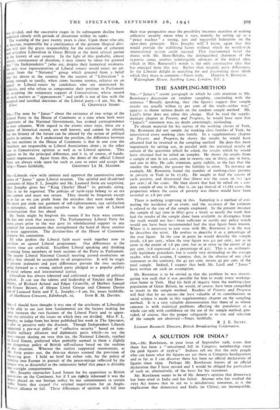THE SAMPLING-METHOD
SIR,—" Janus's " recent paragraph in which he calls attention to Mr. Rowntree's discussion on random sampling, concluding with the sentence " Broadly speaking, they (the figures) suggest that sample results are usually within 15 per cent. of the truth—either way," appears to throw serious doubt on the random sample method. Mr. Lyall's letter does not rebut this charge. Had he read the supple- mentary chapter in Poverty and Progress, he would have seen that " Janus's " statement was, no doubt unwittingly, misleading.
To obtain material for his survey of the working classes of York, Mr. Rowntree did not sample ;lie working class families of York; he interviewed every working class family. In a supplementary chapter to Poverty and Progress, he shows the results he would have obtained had he resorted to the sampling method He does this most ingeniously by setting out, in parallel with the statistical results of certain of the questions which he asked, the results which he would have obtained had he relied on samples. He shows he results from a sample of one in ten cases, one in twenty, one in thirty, one in forty, and one in fifty. He calls attention, quite rightly, to the fact that the smaller the sample, the greater the liability to error. To instance an example, Mr. Rowntree found the number of working-class persons in poverty in York to be 17,185. He sought to find the causes of such poverty, and discovered that illness was the cause in 705 (4.0 per cent.) of the cases. He then shows that had he relied on a ran- dom sample of one in fifty, that is, on 345 instead of 17,185 cases, the proportion where the cause of poverty was illness would have been revealed as 5.8 per cent There is nothing surprising in this. Sampling is a method of esti- mating the incidence of an event, and the accuracy of the estimate is related to the size of the sample employed. In the present instance the sample of 345 (one in fifty) gave a result so nearly the truth that had the results of the sample alone been available its divergence from the truth would not has.: been sufficient to justify any policy wnich would not have been recommended had the true figure been known. Where it is necessary to join issue with Mr. Rowntree is in the way he describes the error. He prefers to describe it as a percentage of the true figure. In the case in point he would describe the sample result, 5.8 per cent., when the true figure was 4.o per cent., not as in error to the extent of 1.8 per cent. but as in error to the extent of 45 per cent. (1.8 expressed as a percentage of 4.o). This is an arithmeti- cally legitimate procedure, but is surely very misleading to the average reader, who will assume, I surmise, that, in the absence of any clear statement to the contrary, the 45 per cent. means 45 per Lent. of the total sample. Indeed, I suspect that both Mr. Lyall and " Janus " have written on such an assumption.
Mr. Rowntree is to be envied in that the problem he was investi- gating was such that it was possible for him to study every working- class home in York. Had his field of inquiry been the working-class population of Great Britain, he would, of course, have been compelled to resort to the sample method. Readers of Poverty and Progress will find that by no means the least valuable of its contributions to social science is made in this supplementary chapter on the sampling method. It is a very valuable demonstration that those of us whose concern is with statistical problems affecting the population as a whole can rely with confidence on the use of the sample method, pro- vided, of course, that the proper safeguards as to size and selection - of the sample are observed —Yours faithfully.


























 Previous page
Previous page